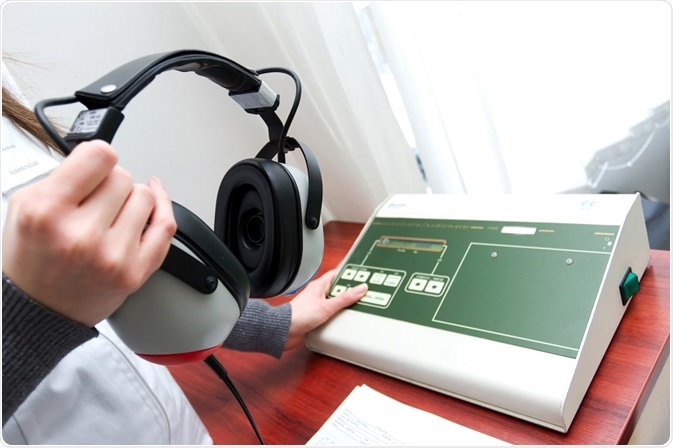Audiometry is a technique used to measure the ability to hear sounds. The process of audiometry is quite simple, consisting of three parts:
- Mechanical sound transmission (middle ear function)
- Neural sound transmission (cochlear function)
- Speech discrimination ability (central integration)

Credit: MDC Digital Studio/Shutterstock.com
An audiometer is referred to a complex instrument which helps to measure a person's ability to hear. Various audiometric techniques and procedures are used to identify the hearing ability of a person.
Pure-tone audiometry
Pure-tone audiometry is considered to be the gold standard in the evaluation of auditory sensitivity. The extent of hearing loss and the cause is determined using pure-tone audiometry. It helps in finding out the hearing thresholds at different frequencies.
The range of pure-tone audiometers vary from simple inexpensive devices to elaborate and expensive diagnostic audiometers. In this test, a pure tone is presented to the ear through an earphone, and the lowest intensity at which the tone is perceived 50% of the time is measured in decibels (dB). This measurement is termed as ‘threshold’. The output is plotted as a graph known as audiogram. Testing procedure is performed at specific frequencies ranging from 250 to 8000 Hz.
Speech audiometry
The objective of the speech audiometry is to assess the integrity of the entire auditory system by evaluating the hearing ability. Neural type of hearing loss can be identified with the help of speech audiometry. Speech audiometric test is further categorized into speech discrimination test and speech reception threshold test.
Both the tests aim to identify the lowest decibel intensity at which a patient can repeat 50% of the words correctly. While speech discrimination test uses monosyllable test words, speech reception threshold test utilizes two syllable words with equal stress (also referred to as “spondees”).
Suprathreshold audiometry
Recruitment is referred to the condition where patients having different degrees of hearing loss in both ears experience enhancement in perceived loudness in response to small increase in the intensity.
Recruitment detection tests are known as the suprathreshold audiometry. At a typical conversational speech level, it helps detecting whether the listener can accurately recognize the speech or not. Benefits to a patient due to the use of a hearing aid can also be determined by this test.
Self-recording audiometry
Self-recording audiometry is also referred to as Bekesy audiometry. In 1947, George von Bekesy first introduced this test. In this procedure, intensity and frequency are automatically changed with the help of a motor.
The frequency can be changed in a forward or backward manner. This hearing test is performed using a recording attenuator. At a fixed rate of so many decibels per second, the attenuator can either increase or decrease the signal intensity. The attenuator action can be controlled by the listener.
Impedance audiometry
The mobility and air pressure of the middle ear system and middle ear reflexes are measured in impedance audiometry.
Computer-administered (microprocessor) audiometry
The first commercial microprocessor audiometer was introduced in 1975. The typical microprocessor audiometer instrument contains a multifunctional keypad. Compared to the manual and self-recording audiometers, microprocessor audiometers offer significant advantages.
Subjective audiometry
In this test, the subjects are asked to respond when they hear the presented sound. This audiometric test can present systematically varying acoustic stimuli to the subjects and record their responses.
Objective audiometry
Unlike subjective audiometry, this test is not dependent on responses from the patients. However, the subjects are asked to co-operate during the attachment of the measuring electrodes or probes for carrying out the objective test.
Further Reading
Last Updated: Oct 12, 2022